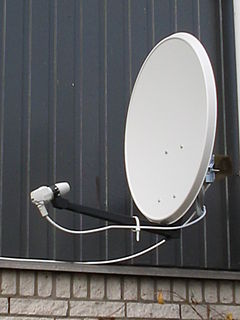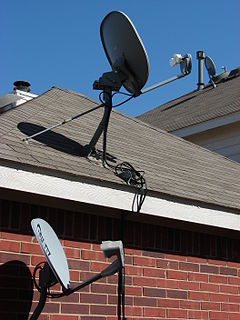
A communications satellite is an artificial satellite that relays and amplifies radio telecommunications signals via a transponder; it creates a communication channel between a source transmitter and a receiver at different locations on Earth. Communications satellites are used for television, telephone, radio, internet, and military applications. There are about 2,000 communications satellites in Earth's orbit, used by both private and government organizations. Many are in geostationary orbit 22,236 miles (35,785 km) above the equator, so that the satellite appears stationary at the same point in the sky, so the satellite dish antennas of ground stations can be aimed permanently at that spot and do not have to move to track it.

DISH Network Corporation is a U.S. television provider based in Englewood, Colorado. It is the owner of the direct-broadcast satellite provider DISH, also still commonly known as DISH Network, and the over-the-top IPTV service Sling TV. The company has approximately 16,000 employees. Like many other providers, DISH is being affected by the cord-cutting trend where people are shifting towards internet based streaming television. Ending 2018, DISH lost 381,000 subscribers in its Q4 2018. DISH had 9.9 million satellite subscribers, down from 11 million year the previous year, and 14 million subscribers in 2014. Its primary competitors are AT&T's satellite service known as DirecTV and cable television providers. The company revenues for FY 2018 were $13.6 billion.
The Ku band is the portion of the electromagnetic spectrum in the microwave range of frequencies from 12 to 18 gigahertz (GHz). The symbol is short for "K-under", because it is the lower part of the original NATO K band, which was split into three bands because of the presence of the atmospheric water vapor resonance peak at 22.24 GHz, (1.35 cm) which made the center unusable for long range transmission. In radar applications, it ranges from 12 to 18 GHz according to the formal definition of radar frequency band nomenclature in IEEE Standard 521-2002.
Television receive-only (TVRO) is a term used chiefly in North America to refer to the reception of satellite television from FSS-type satellites, generally on C-band analog; free-to-air and unconnected to a commercial DBS provider. TVRO was the main means of consumer satellite reception in the United States and Canada until the mid-1990s with the arrival of direct-broadcast satellite television services such as PrimeStar, USSB, Bell TV, DirecTV, Dish Network, Sky TV that transmit Ku signals. While these services are at least theoretically based on open standards, the majority of services are encrypted and require proprietary decoder hardware. TVRO systems relied on feeds being transmitted unencrypted and using open standards, which heavily contrasts to DBS systems in the region.

A satellite dish is a dish-shaped type of parabolic antenna designed to receive or transmit information by radio waves to or from a communication satellite. The term most commonly means a dish used by consumers to receive direct-broadcast satellite television from a direct broadcast satellite in geostationary orbit.

A very small aperture terminal (VSAT) is a two-way satellite ground station with a dish antenna that is smaller than 3.8 meters. The majority of VSAT antennas range from 75 cm to 1.2 m. Data rates, in most cases, range from 4 kbit/s up to 16 Mbit/s. VSATs access satellites in geosynchronous orbit or geostationary orbit to relay data from small remote Earth stations (terminals) to other terminals or master Earth station "hubs".

4DTV is a proprietary broadcasting standard and technology for digital cable broadcasting and C-band/Ku-band satellite dishes from Motorola, using General Instrument's DigiCipher II for encryption. It can tune in both analog VideoCipher 2 and digital DCII satellite channels.

A low-noise block downconverter (LNB) is the receiving device mounted on satellite dishes used for satellite TV reception, which collects the radio waves from the dish and converts them to a signal which is sent through a cable to the receiver inside the building. Also called a low-noise block, low-noise converter (LNC), or even low-noise downconverter (LND), the device is sometimes inaccurately called a low-noise amplifier (LNA).

The Goldstone Deep Space Communications Complex (GDSCC), commonly called the Goldstone Observatory, is a satellite ground station located in the Mojave Desert near Barstow in the U.S. state of California. Operated by NASA's Jet Propulsion Laboratory (JPL), its main purpose is to track and communicate with space missions. It is named after Goldstone, California, a nearby gold-mining ghost town.
Satellite Internet access is Internet access provided through communications satellites. Modern consumer grade satellite Internet service is typically provided to individual users through geostationary satellites that can offer relatively high data speeds, with newer satellites using Ku band to achieve downstream data speeds up to 506 Mbit/s.
Free-to-air (FTA) are television (TV) and radio services broadcast in clear (unencrypted) form, allowing any person with the appropriate receiving equipment to receive the signal and view or listen to the content without requiring a subscription, other ongoing cost, or one-off fee. In the traditional sense, this is carried on terrestrial radio signals and received with an antenna.

Bell TV, is the division of BCE Inc. that provides satellite television service across Canada. It launched on September 10, 1997. As of April 2017, Bell TV provides over 700 channels to over 1 million subscribers. Its major competitors include satellite service Shaw Direct, as well as various cable and communications companies across Canada.

A diplexer is a passive device that implements frequency-domain multiplexing. Two ports are multiplexed onto a third port. The signals on ports L and H occupy disjoint frequency bands. Consequently, the signals on L and H can coexist on port S without interfering with each other.

An offset dish antenna or off-axis dish antenna is a type of parabolic antenna. It is so called because the antenna feed is offset to the side of the reflector, in contrast to the common "front-feed" parabolic antenna where the feed antenna is suspended in front of the dish, on its axis. As in a front-fed parabolic dish, the feed is located at the focal point of the reflector, but the reflector is an asymmetric segment of a paraboloid, so the focus is located to the side.

The Minidish is the tradename used for the small-sized satellite dish used by Freesat and Sky. The term has entered the vocabulary in the UK and Ireland as a generic term for a satellite dish, particularly small ones.
Satellite television is a service that delivers television programming to viewers by relaying it from a communications satellite orbiting the Earth directly to the viewer's location. The signals are received via an outdoor parabolic antenna commonly referred to as a satellite dish and a low-noise block downconverter.

A free-to-air or FTA Receiver is a satellite television receiver designed to receive unencrypted broadcasts. Modern decoders are typically compliant with the MPEG-2/DVB-S and more recently the MPEG-4/DVB-S2 standard for digital television, while older FTA receivers relied on analog satellite transmissions which have declined rapidly in recent years.

Radio is the technology of signaling and communicating using radio waves. Radio waves are electromagnetic waves of frequency between 30 hertz (Hz) and 300 gigahertz (GHz). They are generated by an electronic device called a transmitter connected to an antenna which radiates the waves, and received by a radio receiver connected to another antenna. Radio is very widely used in modern technology, in radio communication, radar, radio navigation, remote control, remote sensing and other applications.

Tooway satellite broadband Internet service available across Europe. The first version of the service was launched in 2007 via two Eutelsat geostationary satellites, Hot Bird 6 and Eurobird 3, respectively at the 13° and 33° East orbital positions.

Currently, there are two primary satellite television providers of subscription based service available to United States consumers: DirecTV and Dish Network, which have 21 and 10 million subscribers respectively.














